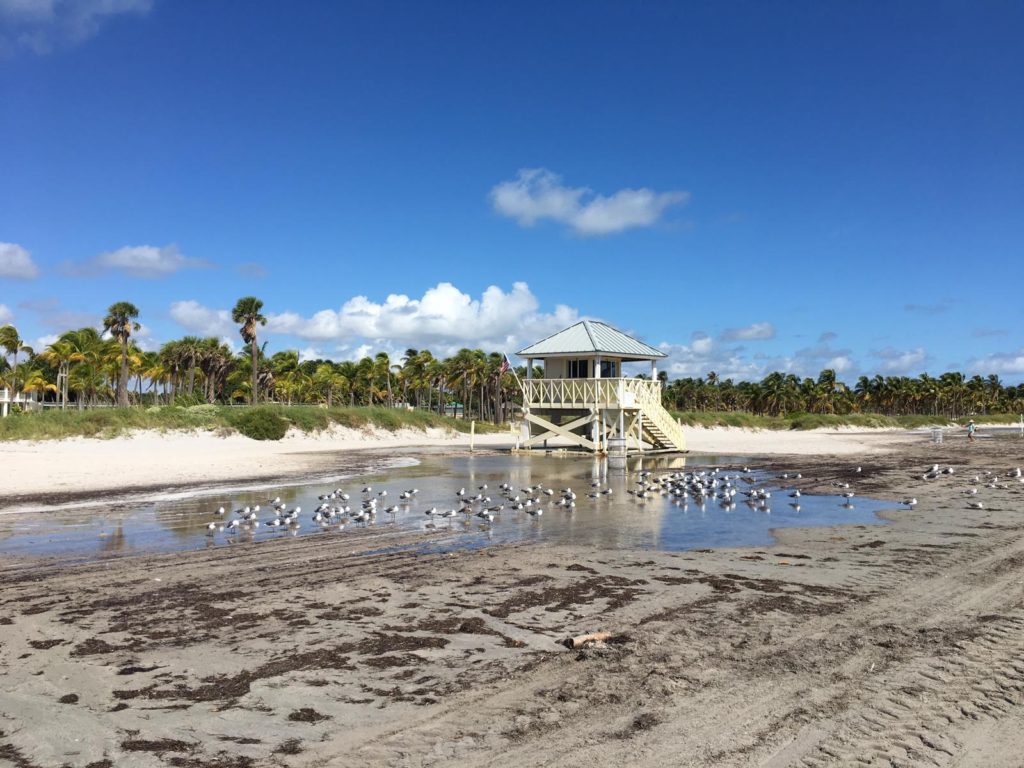No-Swim Advisories for Key Biscayne Beaches as Bacteria Rises Again
Annali HaywardOctober 4, 2019

King tides trapped water near lifeguard station 11 on Crandon Park South beach, 28 Sept. Elevated bacterial readings closed several Key Biscayne beaches again this weekend. (Key News/Annali Hayward)
Another weekend, another change of plans for would-be beachgoers. Tests this week prompted the Florida Department of Health to issue swimming advisories for Key Biscayne Beach, Crandon Park North, and all of Bill Baggs Cape Florida State Park.
The tests, conducted Wednesday, show levels of enterococcus bacteria higher than 70.5 per 100ml of water – the level at which the federal Environmental Protection Agency recommends an advisory.
Crandon Park South showed only ‘moderate’ levels of bacteria, so no advisory was issued for that location. The testing site at the Key Biscayne Beach Club also passed tests Wednesday, whereas the public beach – right next door – failed the following day. More results are due Tuesday for the island’s beaches, which have been plagued with issues all summer.
Jake Ozyman, Director of Public Works and Building Zoning and Planning said the Village of Key Biscayne is funding a contract with the University of Miami for a Ph.D. study on water quality. Ozyman asked lead professor of the study, Helena Solo-Gabriele, for her take Friday morning.
Solo-Gabriele linked the king tides Key Biscayne has been experiencing in the past week with the time of high tide on testing day.
“I think what may have happened is that the king tides influenced the elevated readings,” said Solo-Gabriele. “The data show that the source of the bacteria is the sand area right above the high tide line. During king tide and high wind conditions the bacteria are released from this zone.”
Ozyman said the sand can naturally contain these types of bacteria from plants and seaweed, and that it does not necessarily indicate the presence of fecal matter – though it is more likely. The EPA chose enterococci as a “marker” for their testing process, he said, because “it’s easier and cheaper to detect than other forms.”
But, says Solo-Gabriele, “it is unlikely that the source is the wastewater treatment plant.”
Water testing results are tracked by Miami Waterkeeper, who upload results on the Swim Guide app. Miami Waterkeeper Program Director Laura Chaibongsai said, “the water around Key Biscayne is very dynamic, due to tides and currents and wind. Therefore we regularly see high levels of bacteria in one area but normal levels in an area close by. Then when retested a day or two later, the results may change since the water has moved.”
Chaibongsai also linked king tides to the raised bacterial levels.
Mayor Mike Davey and Village Manager Andrea Agha were in Jacksonville Friday for meetings with the Army Corps of Engineers relating to beach renourishment and were unavailable for comment.


